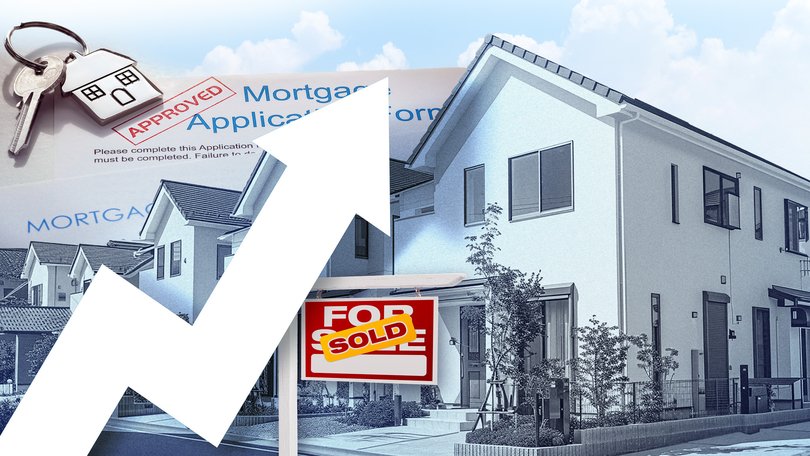Average new Australian mortgage hits record high of $694,000 before 5 per cent first-home deposit scheme

Homebuyers have taken advantage of lower interest rates to embark on a borrowing binge that has driven up prices before an expected surge in first-home buyers hits the market.
The average Australian mortgage for people living their own home hit a record $694,000 in September, with the $52,000 rise driven by double-digit increases in three states over the previous year that far outpaced wage gains.
National borrowing levels surged 8.1 per cent in the year ending September 30, the Australian Bureau of Statistics data showed, reflecting cheaper money after Reserve Bank rate cuts in February, May and August. The increase was more than double the 3.4 per cent wages rise across the economy.
Sign up to The Nightly's newsletters.
Get the first look at the digital newspaper, curated daily stories and breaking headlines delivered to your inbox.
By continuing you agree to our Terms and Privacy Policy.What is the average size new mortgages?
The average size of new mortgages for people living in their own home soared by double-digit figures in Queensland, Western Australia and South Australia. New loans hit record highs in Victoria and Tasmania, Australia’s weaker housing markets, along with NSW, by far Australia’s most expensive.
Investor loan activity drove most of the lending market resurgence, with a 12.3 per cent increase in the number of new mortgages over the year.
Housing prices are strong despite weak growth in owner-occupier and first-home buyer lending, which grew 1.7 per cent and 0.9 per cent respectively.
First-home buyers made up 20.9 per cent of new borrowers, compared with 40.7 per cent for investors.
AMP chief economist Shane Oliver said the Labor Government’s 5 per cent deposit scheme for first home buyers was likely to further fuel prices.
“The likelihood is that the scheme will invigorate first-home buyer demand,” he told The Nightly.
“It actually looked to be going sideways in the September quarter. The growth was mainly in investor borrowing but if we now invigorate first-home buyer borrowing, it probably adds to the heat in an already overheated market.”
The latest increase in both owner-occupier and investor loans occurred before the Federal Government’s new 5 per cent Deposit Scheme came into effect on October 1, covering all property newcomers regardless of income.
Labor’s program means a first-home borrower doesn’t need the usual 20 per cent deposit to avoid having to pay lenders’ mortgage insurance, with taxpayers instead becoming the guarantors.
The value of new investor loans hit a new record high of $39.8 billion in the September quarter. The number of new investor loans was also a record at 57,624.
Dr Mish Tan, the ABS’s head of finance statistics, said RBA rate cuts in 2025 had spurred investor activity.
“Falling borrowing costs and low vacancy rates are favourable conditions for investors,” she said.
State of loans
The average new mortgage size for owner-occupiers hit a new record high, growing by 8.1 per cent over the year to September.
Australia’s average new mortgage of $694,000 for owner-occupiers, means a borrower with a 20 per cent deposit would be buying a home worth $867,500. This is a level well below the mid-point house price in Australia’s major capital cities.
In NSW, the average new mortgage was even higher at $828,000, another new record, following an annual increase of 6.3 per cent.
With a 20 per cent deposit, this would buy a house worth $1.035 million. In Sydney that would only net a house in an outer suburb in the city’s south-west.
Western Australia had the biggest annual increase of 13.4 per cent. The $75,000 increase took average mortgages to $633,000, which would buy a $791,250 home with a 20 per cent deposit. This state also has Australia’s strongest population growth, mainly from interstate migration.
Queensland recorded a 12.8 per cent increase over the year, taking the average new mortgage to a record $687,000, which would buy a home worth $858,750. The Sunshine State last year overtook Victoria to have Australia’s second higher average new mortgage.
“It’s population growth in the case of Queensland and WA,” Dr Oliver said.
South Australia saw a 10.8 per cent increase, taking it to $616,000 which would buy a $770,000 house in a state with weaker than average population growth.
“They’re becoming well and truly overvalued, particularly South Australia. South Australia seems to be running on the back of FOMO at present. People are still trying to get in for fear that if they don’t get in, they’ll miss out,” he said.
Victoria had a more subdued 4.7 per cent annual increase, taking the average new mortgage to $647,000, which would buy a house worth $808,750 with a 20 per cent deposit.
Tasmania, another weaker housing market, had a 6.4 per cent increase to $484,000 which would buy a $605,000 house with the equivalent deposit.

